Does Multidimensional Urban Morphology Affect Thermal Sensation? Evidence from Shanghai
Abstract
1. Introduction
2. Study Area and Data Sources
2.1. Study Area
2.2. Data Resources
2.2.1. Acquisition and Calibration of Remote Sensing Images of Urban Surface Space
2.2.2. Acquisition and Management of Urban Surface Spatial Morphology Data in Central Urban Area of Shanghai
2.2.3. Acquisition of TSF Social Media Data
3. Methodology
3.1. Selection and Treatment of UM Indicators
3.2. LST Retrieval
3.3. TSF Data Processing, Induction, and Quantification
3.4. Model Selection
4. Results
4.1. Spatial Distribution Characteristics of TSF and LST in the Central Urban Area of Shanghai
4.2. The Surface Spatial Form of the Central Urban Area of Shanghai
4.3. The Relationship Between the UM Variable and UTE
4.3.1. Results of the UM Variables with the TSF OLS Model
4.3.2. Results of the UM Variables with the LST OLS Model
5. Discussion
5.1. The Effect of UM Variables on UTE
5.2. Mechanism of Different Effects of UM on TSF and LST
5.3. Limitations and Shortcomings
6. Conclusions
Author Contributions
Funding
Data Availability Statement
Acknowledgments
Conflicts of Interest
References
- Wang, Y.; Chen, L.; Kubota, J. The Relationship between Urbanization, Energy Use and Carbon Emissions: Evidence from a Panel of Association of Southeast Asian Nations (ASEAN) Countries. J. Clean. Prod. 2016, 112, 1368–1374. [Google Scholar] [CrossRef]
- Coutts, A.M.; Harris, R.J.; Phan, T.; Livesley, S.J.; Williams, N.S.G.; Tapper, N.J. Thermal Infrared Remote Sensing of Urban Heat: Hotspots, Vegetation, and an Assessment of Techniques for Use in Urban Planning. Remote Sens. Environ. 2016, 186, 637–651. [Google Scholar] [CrossRef]
- Zhao, J.; Guo, F.; Zhang, H.; Dong, J. Mechanisms of Non-Stationary Influence of Urban Form on the Diurnal Thermal Environment Based on Machine Learning and MGWR Analysis. Sustain. Cities Soc. 2024, 101, 105194. [Google Scholar] [CrossRef]
- Patel, S.; Indraganti, M.; Jawarneh, R.N. A Comprehensive Systematic Review: Impact of Land Use/Land Cover (LULC) on Land Surface Temperatures (LST) and Outdoor Thermal Comfort. Build. Environ. 2024, 249, 111130. [Google Scholar] [CrossRef]
- Mirzaei, P.A. Recent Challenges in Modeling of Urban Heat Island. Sustain. Cities Soc. 2015, 19, 200–206. [Google Scholar] [CrossRef]
- Aynsley, R.; Spruill, M. Thermal Comfort Models for Outdoor Thermal Comfort in Warm Humid Climates and Probabilities of Low Wind Speeds. J. Wind Eng. Ind. Aerodyn. 1990, 36, 481–488. [Google Scholar] [CrossRef]
- Höppe, P. Different Aspects of Assessing Indoor and Outdoor Thermal Comfort. Energy Build. 2002, 34, 661–665. [Google Scholar] [CrossRef]
- Nikolopoulou, M.; Steemers, K. Thermal Comfort and Psychological Adaptation as a Guide for Designing Urban Spaces. Energy Build. 2003, 35, 95–101. [Google Scholar] [CrossRef]
- Ng, E.; Cheng, V. Urban Human Thermal Comfort in Hot and Humid Hong Kong. Energy Build. 2012, 55, 51–65. [Google Scholar] [CrossRef]
- ASHRAE 55-1992; Thermal Environmental Conditions for Human Occupancy. American Society of Heating, Refrigerating and Air-conditioning Engineers Inc.: Atlanta, GA, USA, 1992.
- Alghamdi, S.; Tang, W.; Kanjanabootra, S.; Alterman, D. Field Investigations on Thermal Comfort in University Classrooms in New South Wales, Australia. Energy Rep. 2023, 9, 63–71. [Google Scholar] [CrossRef]
- Kim, J.; Zhou, Y.; Schiavon, S.; Raftery, P.; Brager, G. Personal Comfort Models: Predicting Individuals’ Thermal Preference Using Occupant Heating and Cooling Behavior and Machine Learning. Build. Environ. 2018, 129, 96–106. [Google Scholar] [CrossRef]
- ISO 7730; Moderate Thermal Environment, Determination of PMV and PPD Indices and Specification of the Condition for Thermal Comfort. International Organization for Standardization: Geneva, Switzerland, 1994.
- Kumar, P.; Sharma, A. Study on Importance, Procedure, and Scope of Outdoor Thermal Comfort—A Review. Sustain. Cities Soc. 2020, 61, 102297. [Google Scholar] [CrossRef]
- Kántor, N.; Égerházi, L.; Unger, J. Subjective Estimation of Thermal Environment in Recreational Urban Spaces—Part 1: Investigations in Szeged, Hungary. Int. J. Biometeorol. 2012, 56, 1075–1088. [Google Scholar] [CrossRef] [PubMed]
- Mirzabeigi, S.; Khalili Nasr, B.; Mainini, A.G.; Blanco Cadena, J.D.; Lobaccaro, G. Tailored WBGT as a Heat Stress Index to Assess the Direct Solar Radiation Effect on Indoor Thermal Comfort. Energy Build. 2021, 242, 110974. [Google Scholar] [CrossRef]
- Kumar, P.; Sharma, A. Assessing Outdoor Thermal Comfort Conditions at an Urban Park during Summer in the Hot Semi-Arid Region of India. Mater. Today Proc. 2022, 61, 356–369. [Google Scholar] [CrossRef]
- Bröde, P.; Krüger, E.L.; Rossi, F.A.; Fiala, D. Predicting Urban Outdoor Thermal Comfort by the Universal Thermal Climate Index UTCI—A Case Study in Southern Brazil. Int. J. Biometeorol. 2012, 56, 471–480. [Google Scholar] [CrossRef]
- Mahdavinejad, M.; Shaeri, J.; Nezami, A.; Goharian, A. Comparing Universal Thermal Climate Index (UTCI) with Selected Thermal Indices to Evaluate Outdoor Thermal Comfort in Traditional Courtyards with BWh Climate. Urban Clim. 2024, 54, 101839. [Google Scholar] [CrossRef]
- Sharmin, T.; Steemers, K.; Humphreys, M. Outdoor Thermal Comfort and Summer PET Range: A Field Study in Tropical City Dhaka. Energy Build. 2019, 198, 149–159. [Google Scholar] [CrossRef]
- Ugursal, A.; Culp, C. Gender Differences of Thermal Comfort Perception UnderTransient Environmental and Metabolic Conditions—ProQuest. ASHRAE Trans. 2013, 119, 52–62. [Google Scholar]
- Xiong, J.; Lian, Z.; Zhou, X.; You, J.; Lin, Y. Effects of Temperature Steps on Human Health and Thermal Comfort. Build. Environ. 2015, 94, 144–154. [Google Scholar] [CrossRef]
- Nkurikiyeyezu, K.N.; Suzuki, Y.; Lopez, G.F. Heart Rate Variability as a Predictive Biomarker of Thermal Comfort. J. Ambient. Intell. Hum. Comput. 2018, 9, 1465–1477. [Google Scholar] [CrossRef]
- Xiong, J.; Lian, Z.; Zhang, H. Physiological Response to Typical Temperature Step-Changes in Winter of China. Energy Build. 2017, 138, 687–694. [Google Scholar] [CrossRef]
- Nikolopoulou, M.; Baker, N.; Steemers, K. Thermal Comfort in Outdoor Urban Spaces: Understanding the Human Parameter. Sol. Energy 2001, 70, 227–235. [Google Scholar] [CrossRef]
- Lindner-Cendrowska, K.; Błażejczyk, K. Impact of Selected Personal Factors on Seasonal Variability of Recreationist Weather Perceptions and Preferences in Warsaw (Poland). Int. J. Biometeorol. 2018, 62, 113–125. [Google Scholar] [CrossRef]
- Villadiego, K.; Velay-Dabat, M.A. Outdoor Thermal Comfort in a Hot and Humid Climate of Colombia: A Field Study in Barranquilla. Build. Environ. 2014, 75, 142–152. [Google Scholar] [CrossRef]
- Ge, J.; Wu, J.; Chen, S.; Wu, J. Energy Efficiency Optimization Strategies for University Research Buildings with Hot Summer and Cold Winter Climate of China Based on the Adaptive Thermal Comfort. J. Build. Eng. 2018, 18, 321–330. [Google Scholar] [CrossRef]
- Aghniaey, S.; Lawrence, T.M.; Sharpton, T.N.; Douglass, S.P.; Oliver, T.; Sutter, M. Thermal Comfort Evaluation in Campus Classrooms during Room Temperature Adjustment Corresponding to Demand Response. Build. Environ. 2019, 148, 488–497. [Google Scholar] [CrossRef]
- Arens, E.; Humphreys, M.A.; de Dear, R.; Zhang, H. Are ‘Class A’ Temperature Requirements Realistic or Desirable? Build. Environ. 2010, 45, 4–10. [Google Scholar] [CrossRef]
- Hoyt, T.; Lee, K.H.; Zhang, H.; Arens, E.; Webster, T. Energy Savings from Extended Air Temperature Setpoints and Reductions in Room Air Mixing; UC Berkeley: Berkeley, CA, USA, 2005. [Google Scholar]
- Humphreys, M.A.; Hancock, M. Do People like to Feel ‘Neutral’?: Exploring the Variation of the Desired Thermal Sensation on the ASHRAE Scale. Energy Build. 2007, 39, 867–874. [Google Scholar] [CrossRef]
- Fox, R.H.; Woodward, P.M.; Exton-Smith, A.N.; Green, M.F.; Donnison, D.V.; Wicks, M.H. Body Temperatures in the Elderly: A National Study of Physiological, Social and Environmental Conditions. Br. Med. J. 1973, 1, 200–206. [Google Scholar] [CrossRef]
- Yuan, B.; Zhou, L.; Hu, F.; Wei, C. Effects of 2D/3D Urban Morphology on Land Surface Temperature: Contribution, Response, and Interaction. Urban Clim. 2024, 53, 101791. [Google Scholar] [CrossRef]
- Liu, Y.; Peng, J.; Wang, Y. Efficiency of Landscape Metrics Characterizing Urban Land Surface Temperature. Landsc. Urban Plan. 2018, 180, 36–53. [Google Scholar] [CrossRef]
- Peng, J.; Jia, J.; Liu, Y.; Li, H.; Wu, J. Seasonal Contrast of the Dominant Factors for Spatial Distribution of Land Surface Temperature in Urban Areas. Remote Sens. Environ. 2018, 215, 255–267. [Google Scholar] [CrossRef]
- Li, J.; Wang, F.; Fu, Y.; Guo, B.; Zhao, Y.; Yu, H. A Novel SUHI Referenced Estimation Method for Multicenters Urban Agglomeration Using DMSP/OLS Nighttime Light Data. IEEE J. Sel. Top. Appl. Earth Obs. Remote Sens. 2020, 13, 1416–1425. [Google Scholar] [CrossRef]
- Liu, D.; Chen, N.; Zhang, X.; Wang, C.; Du, W. Annual Large-Scale Urban Land Mapping Based on Landsat Time Series in Google Earth Engine and OpenStreetMap Data: A Case Study in the Middle Yangtze River Basin. ISPRS J. Photogramm. Remote Sens. 2020, 159, 337–351. [Google Scholar] [CrossRef]
- Geletič, J.; Lehnert, M.; Savić, S.; Milošević, D. Inter-/Intra-Zonal Seasonal Variability of the Surface Urban Heat Island Based on Local Climate Zones in Three Central European Cities. Build. Environ. 2019, 156, 21–32. [Google Scholar] [CrossRef]
- Stewart, I.D.; Oke, T.R. Local Climate Zones for Urban Temperature Studies. Bull. Am. Meteorol. Soc. 2012, 93, 1879–1900. [Google Scholar] [CrossRef]
- Oke, T.R. Towards Better Scientific Communication in Urban Climate. Theor. Appl. Climatol. 2006, 84, 179–190. [Google Scholar] [CrossRef]
- Chen, S.; He, P.; Yu, B.; Wei, D.; Chen, Y. The Challenge of Noise Pollution in High-Density Urban Areas: Relationship between 2D/3D Urban Morphology and Noise Perception. Build. Environ. 2024, 253, 111313. [Google Scholar] [CrossRef]
- Guo, F.; Schlink, U.; Wu, W.; Hu, D.; Sun, J. Scale-Dependent and Season-Dependent Impacts of 2D/3D Building Morphology on Land Surface Temperature. Sustain. Cities Soc. 2023, 97, 104788. [Google Scholar] [CrossRef]
- Fotheringham, A.S.; Wong, D.W.S. The Modifiable Areal Unit Problem in Multivariate Statistical Analysis. Environ. Plan A 1991, 23, 1025–1044. [Google Scholar] [CrossRef]
- Han, W. Analyzing the Scale Dependent Effect of Urban Building Morphology on Land Surface Temperature Using Random Forest Algorithm. Sci. Rep. 2023, 13, 19312. [Google Scholar] [CrossRef]
- Weng, Q.; Lu, D.; Schubring, J. Estimation of Land Surface Temperature–Vegetation Abundance Relationship for Urban Heat Island Studies. Remote Sens. Environ. 2004, 89, 467–483. [Google Scholar] [CrossRef]
- Li, X.; Zhou, W.; Ouyang, Z. Relationship between Land Surface Temperature and Spatial Pattern of Greenspace: What Are the Effects of Spatial Resolution? Landsc. Urban Plan. 2013, 114, 1–8. [Google Scholar] [CrossRef]
- Niu, H.; Silva, E.A. Crowdsourced Data Mining for Urban Activity: Review of Data Sources, Applications, and Methods. J. Urban Plan. Dev. 2020, 146, 04020007. [Google Scholar] [CrossRef]
- Chen, Y.; Niu, H.; Silva, E.A. The Road to Recovery: Sensing Public Opinion towards Reopening Measures with Social Media Data in Post-Lockdown Cities. Cities 2023, 132, 104054. [Google Scholar] [CrossRef]
- Wang, Z.; Zhou, R.; Yu, Y. The Impact of Urban Morphology on Land Surface Temperature under Seasonal and Diurnal Variations: Marginal and Interaction Effects. Build. Environ. 2025, 272, 112673. [Google Scholar] [CrossRef]
- Yelixiati, H.; Tong, L.; Luo, S.; Chen, Z. Spatiotemporal Heterogeneity of the Relationship between Urban Morphology and Land Surface Temperature at a Block Scale. Sustain. Cities Soc. 2024, 113, 105711. [Google Scholar] [CrossRef]
- Wen, D.; Wang, L.; Cao, Q.; Hong, M.; Wang, H.; Bian, G. A Comparative Study of the Effects of Urban Morphology on Land Surface Temperature in Chengdu and Chongqing, China. Sci. Rep. 2024, 14, 25130. [Google Scholar] [CrossRef]
- Zhou, L.; Hu, F.; Wang, B.; Wei, C.; Sun, D.; Wang, S. Relationship between Urban Landscape Structure and Land Surface Temperature: Spatial Hierarchy and Interaction Effects. Sustain. Cities Soc. 2022, 80, 103795. [Google Scholar] [CrossRef]
- Yin, C.; Yuan, M.; Lu, Y.; Huang, Y.; Liu, Y. Effects of Urban Form on the Urban Heat Island Effect Based on Spatial Regression Model. Sci. Total Environ. 2018, 634, 696–704. [Google Scholar] [CrossRef] [PubMed]
- Hu, Y.; Dai, Z.; Guldmann, J.-M. Modeling the Impact of 2D/3D Urban Indicators on the Urban Heat Island over Different Seasons: A Boosted Regression Tree Approach. J. Environ. Manag. 2020, 266, 110424. [Google Scholar] [CrossRef] [PubMed]
- Wu, Y.; Che, Y.; Liao, W.; Liu, X. The Impact of Urban Morphology on Land Surface Temperature across Urban-Rural Gradients in the Pearl River Delta, China. Build. Environ. 2025, 267, 112215. [Google Scholar] [CrossRef]
- Fanger, P.O. Thermal Comfort; Danish Technical Press: Copenhagen, Denmark, 1970. [Google Scholar]
- Fleiss, J.L.; Cohen, J. The Equivalence of Weighted Kappa and the Intraclass Correlation Coefficient as Measures of Reliability. Educ. Psychol. Meas. 1973, 33, 613–619. [Google Scholar] [CrossRef]
- Morabito, M.; Crisci, A.; Messeri, A.; Orlandini, S.; Raschi, A.; Maracchi, G.; Munafò, M. The Impact of Built-up Surfaces on Land Surface Temperatures in Italian Urban Areas. Sci. Total Environ. 2016, 551–552, 317–326. [Google Scholar] [CrossRef]
- Deilami, K.; Kamruzzaman, M.; Liu, Y. Urban Heat Island Effect: A Systematic Review of Spatio-Temporal Factors, Data, Methods, and Mitigation Measures. Int. J. Appl. Earth Obs. Geoinf. 2018, 67, 30–42. [Google Scholar] [CrossRef]
- Gao, Y.; Zhao, J.; Han, L. Exploring the Spatial Heterogeneity of Urban Heat Island Effect and Its Relationship to Block Morphology with the Geographically Weighted Regression Model. Sustain. Cities Soc. 2022, 76, 103431. [Google Scholar] [CrossRef]
- Li, L.; Zha, Y.; Zhang, J. Spatially Non-Stationary Effect of Underlying Driving Factors on Surface Urban Heat Islands in Global Major Cities. Int. J. Appl. Earth Obs. Geoinf. 2020, 90, 102131. [Google Scholar] [CrossRef]
- Yu, H.; Peng, Z.-R. Exploring the Spatial Variation of Ridesourcing Demand and Its Relationship to Built Environment and Socioeconomic Factors with the Geographically Weighted Poisson Regression. J. Transp. Geogr. 2019, 75, 147–163. [Google Scholar] [CrossRef]
- Anselin, L. Local Indicators of Spatial Association—LISA. Geogr. Anal. 1995, 27, 93–115. [Google Scholar] [CrossRef]
- Wheeler, D.; Tiefelsdorf, M. Multicollinearity and Correlation among Local Regression Coefficients in Geographically Weighted Regression. J. Geogr. Syst. 2005, 7, 161–187. [Google Scholar] [CrossRef]
- Nugroho, N.Y.; Triyadi, S.; Wonorahardjo, S. Effect of High-Rise Buildings on the Surrounding Thermal Environment. Build. Environ. 2022, 207, 108393. [Google Scholar] [CrossRef]
- He, X.; Miao, S.; Shen, S.; Li, J.; Zhang, B.; Zhang, Z.; Chen, X. Influence of Sky View Factor on Outdoor Thermal Environment and Physiological Equivalent Temperature. Int. J. Biometeorol. 2015, 59, 285–297. [Google Scholar] [CrossRef] [PubMed]
- Xiang, Y.; Huang, C.; Huang, X.; Zhou, Z.; Wang, X. Seasonal Variations of the Dominant Factors for Spatial Heterogeneity and Time Inconsistency of Land Surface Temperature in an Urban Agglomeration of Central China. Sustain. Cities Soc. 2021, 75, 103285. [Google Scholar] [CrossRef]
- Han, D.; An, H.; Wang, F.; Xu, X.; Qiao, Z.; Wang, M.; Sui, X.; Liang, S.; Hou, X.; Cai, H.; et al. Understanding Seasonal Contributions of Urban Morphology to Thermal Environment Based on Boosted Regression Tree Approach. Build. Environ. 2022, 226, 109770. [Google Scholar] [CrossRef]
- Scarano, M.; Sobrino, J.A. On the Relationship between the Sky View Factor and the Land Surface Temperature Derived by Landsat-8 Images in Bari, Italy. Int. J. Remote Sens. 2015, 36, 4820–4835. [Google Scholar] [CrossRef]
- Wang, J.; Meng, F.; Lu, H.; Lv, Y.; Jing, T. Individual and Combined Effects of 3D Buildings and Green Spaces on the Urban Thermal Environment: A Case Study in Jinan, China. Atmosphere 2023, 14, 908. [Google Scholar] [CrossRef]
- Li, J.; Song, C.; Cao, L.; Zhu, F.; Meng, X.; Wu, J. Impacts of Landscape Structure on Surface Urban Heat Islands: A Case Study of Shanghai, China. Remote Sens. Environ. 2011, 115, 3249–3263. [Google Scholar] [CrossRef]
- Sun, D.; Kafatos, M. Note on the NDVI-LST Relationship and the Use of Temperature-Related Drought Indices over North America. Geophys. Res. Lett. 2007, 34. [Google Scholar] [CrossRef]
- Wu, Z.; Tong, Z.; Wang, M.; Long, Q. Assessing the Impact of Urban Morphological Parameters on Land Surface Temperature in the Heat Aggregation Areas with Spatial Heterogeneity: A Case Study of Nanjing. Build. Environ. 2023, 235, 110232. [Google Scholar] [CrossRef]
- Nasar-u-Minallah, M.; Haase, D.; Qureshi, S. Evaluating the Impact of Landscape Configuration, Patterns and Composition on Land Surface Temperature: An Urban Heat Island Study in the Megacity Lahore, Pakistan. Environ. Monit. Assess. 2024, 196, 627. [Google Scholar] [CrossRef] [PubMed]
- Liu, H.; Weng, Q. Seasonal Variations in the Relationship between Landscape Pattern and Land Surface Temperature in Indianapolis, USA. Environ. Monit. Assess. 2008, 144, 199–219. [Google Scholar] [CrossRef] [PubMed]
- Li, H.; Li, Y.; Wang, T.; Wang, Z.; Gao, M.; Shen, H. Quantifying 3D Building Form Effects on Urban Land Surface Temperature and Modeling Seasonal Correlation Patterns. Build. Environ. 2021, 204, 108132. [Google Scholar] [CrossRef]
- Coseo, P.; Larsen, L. How Factors of Land Use/Land Cover, Building Configuration, and Adjacent Heat Sources and Sinks Explain Urban Heat Islands in Chicago. Landsc. Urban Plan. 2014, 125, 117–129. [Google Scholar] [CrossRef]
- Yan, J.; Yin, C.; An, Z.; Mu, B.; Wen, Q.; Li, Y.; Zhang, Y.; Chen, W.; Wang, L.; Song, Y. The Influence of Urban Form on Land Surface Temperature: A Comprehensive Investigation from 2D Urban Land Use and 3D Buildings. Land 2023, 12, 1802. [Google Scholar] [CrossRef]
- Cao, J.; Zhou, W.; Zheng, Z.; Ren, T.; Wang, W. Within-City Spatial and Temporal Heterogeneity of Air Temperature and Its Relationship with Land Surface Temperature. Landsc. Urban Plan. 2021, 206, 103979. [Google Scholar] [CrossRef]
- Goldblatt, R.; Addas, A.; Crull, D.; Maghrabi, A.; Levin, G.G.; Rubinyi, S. Remotely Sensed Derived Land Surface Temperature (LST) as a Proxy for Air Temperature and Thermal Comfort at a Small Geographical Scale. Land 2021, 10, 410. [Google Scholar] [CrossRef]
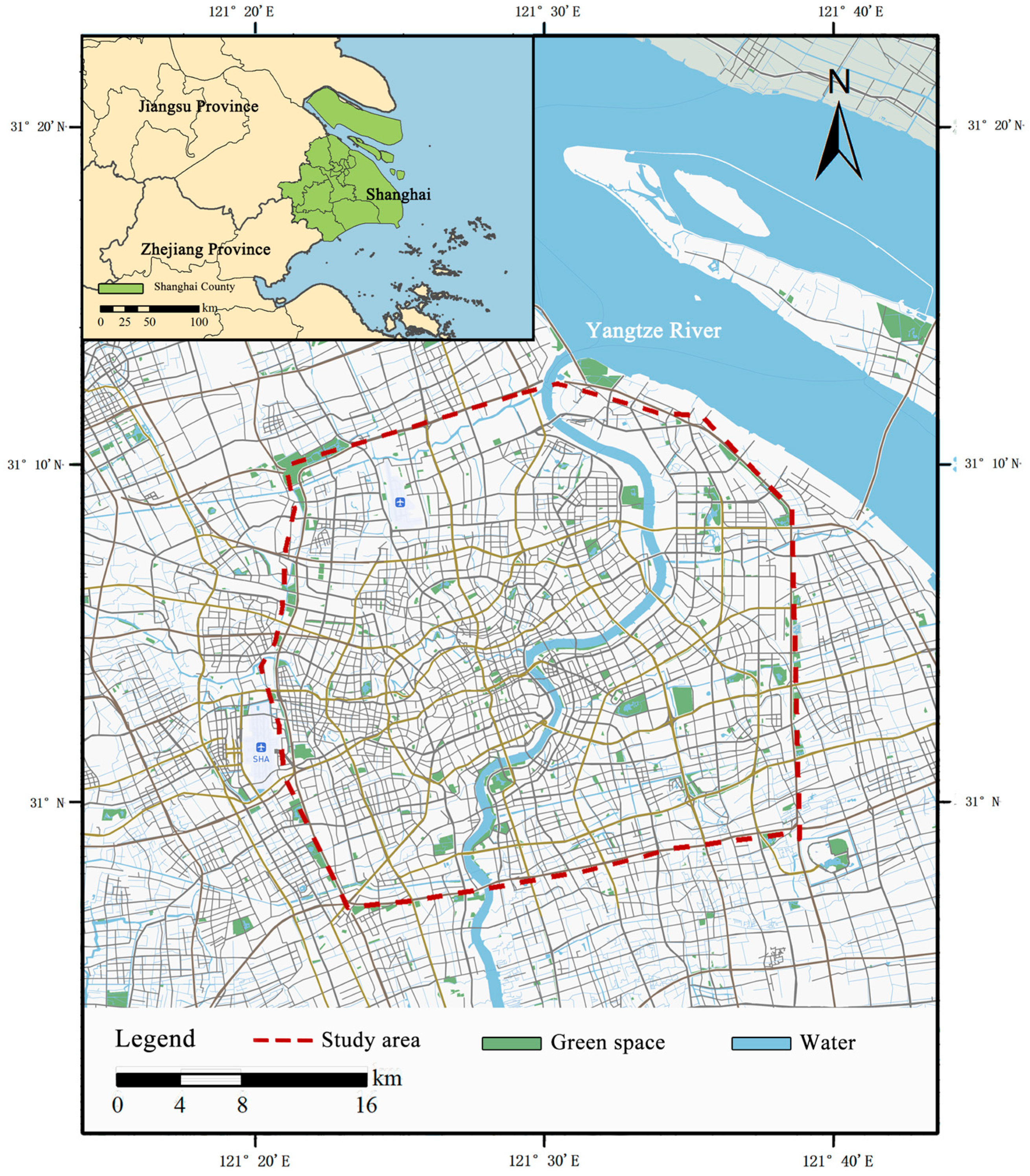
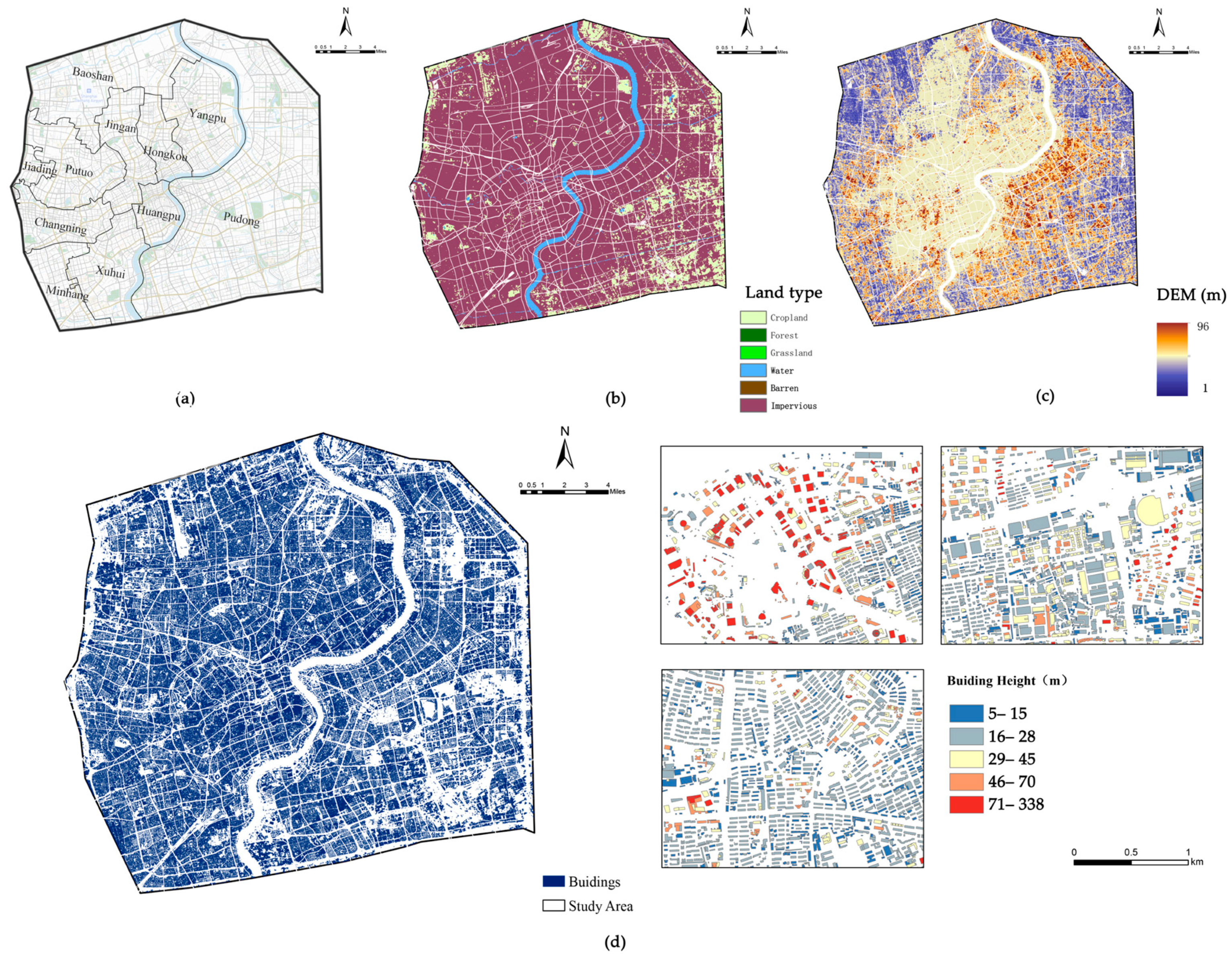
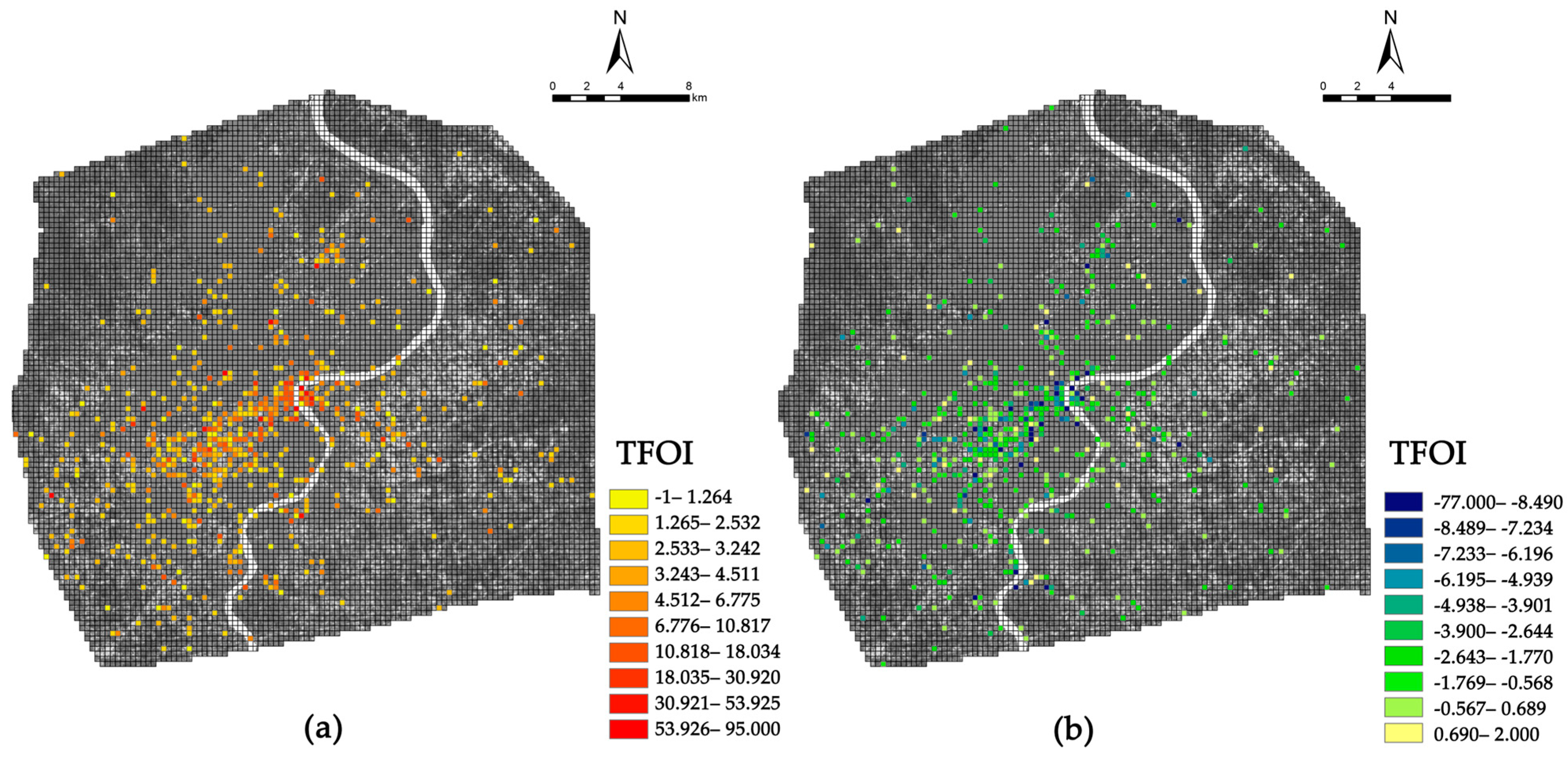
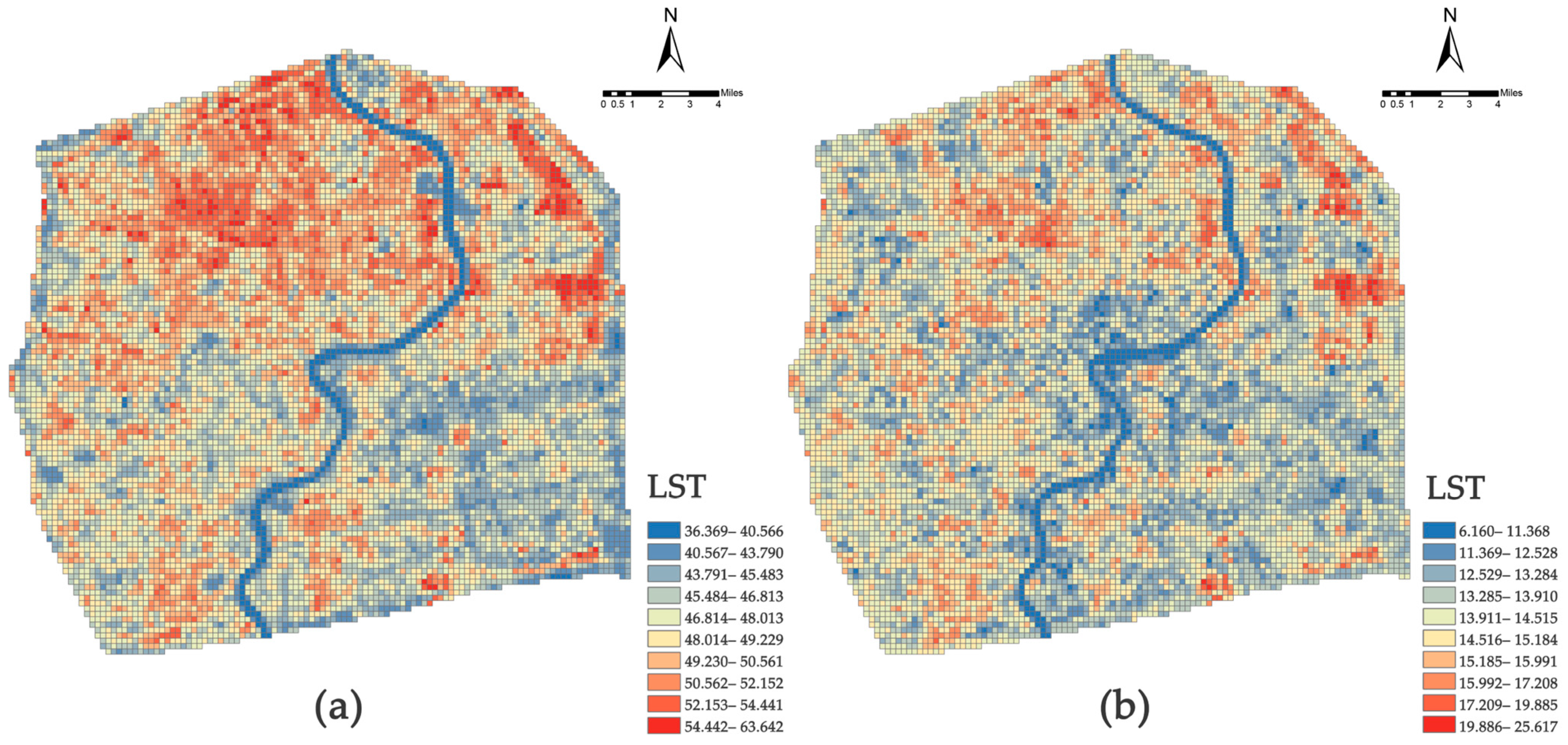
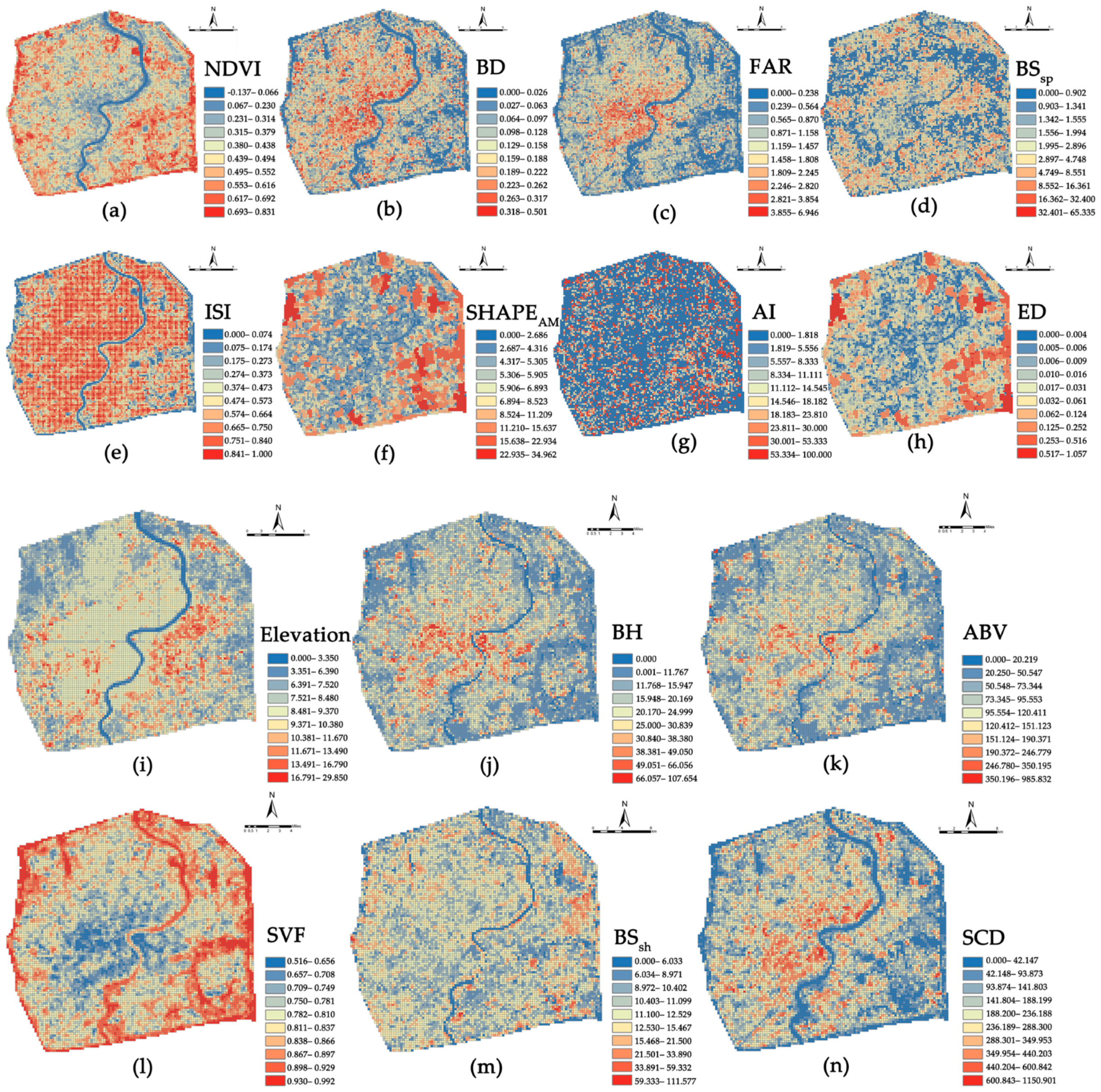
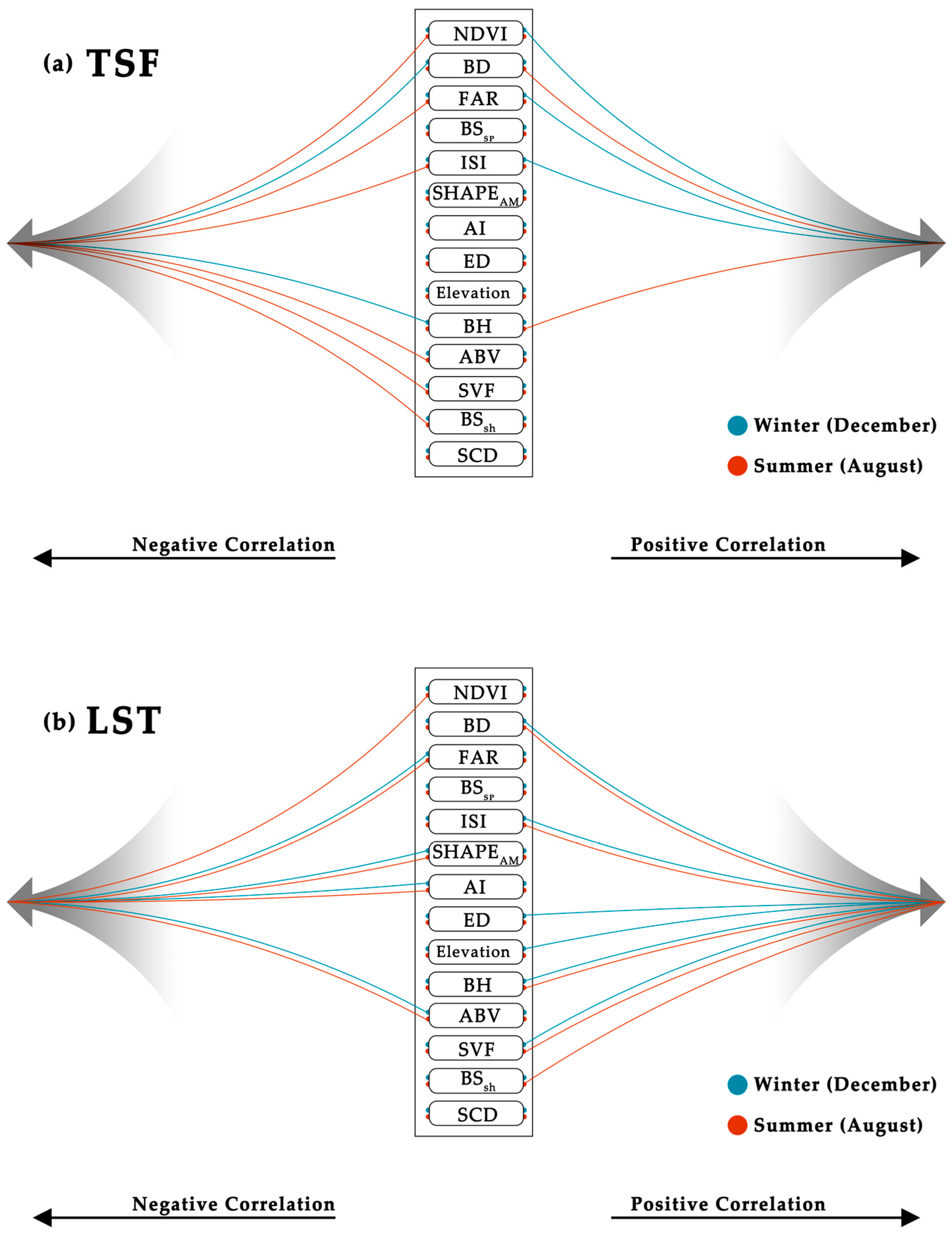
| Norm | Formula | Description | References |
|---|---|---|---|
| 2D Indicators | |||
| Show the extent of the green space. | [51] | ||
| Reflects the extent to which the ground is covered by buildings. | [51] | ||
| Characterize the intensity of land development. | [42,51] | ||
| Average building-to-building distance between buildings in each grid pixel. | [42] | ||
| The proportion of impervious surface coverage per unit area. | [52] | ||
| Reflecting the complexity of specific types of landscape patch boundaries. | [34] | ||
| The aggregation characteristics reflecting the distribution of patches. | [34,53] | ||
| Measure the degree of landscape fragmentation. | [34,53] | ||
| 3D Indicators | |||
| Elevation | Directly from DEM data | Indicates the elevation status of the urban space. | - |
| Directly from the building vector dataset | Indicates the vertical height of the building. | [50] | |
| Reflecting the degree of urban intensification. | [34] | ||
| Reflects spatial openness. | [20,54,55] | ||
| The average of the shape indices of all buildings in each grid pixel. | [42] | ||
| Reflects the density of the distribution of elements within the spatial unit. | [56] |
| Scale | Ruler | Human Perception and Physiological Response |
|---|---|---|
| −3 | Cold | Skin tingling, shortness of breath, high risk of core temperature decline. |
| −2 | Cool | The limbs are stiff and trembling, and may be frostbitten after exposure for 30 min. |
| −1 | Slightly cool | Hands and feet are slightly cold and can be adjusted independently. |
| 0 | Neutral | No active regulation behavior, dry skin, stable heart rate. |
| 1 | Slightly warm | Slight sweating and increased thirst. |
| 2 | Warm | Continuous sweating, increased heart rate, and decreased attention. |
| 3 | Hot | Risk of heat cramps, and failure of thermoregulation. |
| Variables | Coef. | Std. Err. | T | p |
|---|---|---|---|---|
| Summer (August) | ||||
| NDVI | −12.501 | 3.154 | −3.963 | 0.013 ** |
| BD | 22.578 | 11.323 | 1.994 | 0.064 * |
| FAR | −8.878 | 2.496 | −3.557 | 0.006 *** |
| BSsp | 0.057 | 0.060 | 0.963 | 0.307 |
| ISI | −11.925 | 2.214 | −5.387 | 0.001 *** |
| SHAPEAM | −0.237 | 0.164 | −1.438 | 0.259 |
| AI | −0.220 | 0.211 | −1.044 | 0.207 |
| ED | 11.662 | 10.763 | 1.084 | 0.334 |
| Elevation | 0.218 | 0.175 | 1.246 | 0.425 |
| BH | 4.377 | 1.241 | 3.527 | 0.028 ** |
| ABV | −0.012 | 0.007 | −1.739 | 0.089 * |
| SVF | −18.137 | 8.134 | −2.230 | 0.039 ** |
| BSsh | −0.179 | 0.137 | −1.305 | 0.086 * |
| SCD | −0.031 | 0.300 | −0.103 | 0.906 |
| R-squared | 0.119 | |||
| Winter (December) | ||||
| NDVI | 6.61 | 1.799 | 3.675 | 0.041 ** |
| BD | −7.921 | 5.235 | −1.513 | 0.072 * |
| FAR | 3.374 | 1.345 | 2.508 | 0.002 *** |
| BSsp | 0.058 | 0.062 | 0.940 | 0.137 |
| ISI | 4.938 | 1.280 | 3.857 | 0.014 ** |
| SHAPEAM | 0.027 | 0.095 | 0.289 | 0.695 |
| AI | 0.146 | 0.118 | 1.236 | 0.147 |
| ED | −4.567 | 6.359 | −0.718 | 0.404 |
| Elevation | 0.061 | 0.099 | 0.622 | 0.491 |
| BH | −1.692 | 0.640 | −2.645 | 0.069 * |
| ABV | −0.001 | 0.004 | −0.191 | 0.872 |
| SVF | 6.838 | 4.678 | 1.462 | 0.256 |
| BSsh | 0.007 | 0.031 | 0.241 | 0.733 |
| SCD | −0.104 | 0.161 | −0.646 | 0.351 |
| R-squared | 0.081 | |||
| Variables | Coef. | Std. Err. | t | p |
|---|---|---|---|---|
| Summer (August) | ||||
| NDVI | −1.288 | 0.193 | −6.672 | 0.000 *** |
| BD | 19.777 | 0.591 | 33.477 | 0.000 *** |
| FAR | −2.335 | 0.199 | −11.744 | 0.000 *** |
| BSsp | −0.004 | 0.008 | −0.523 | 0.646 |
| ISI | 2.704 | 0.150 | 18.049 | 0.000 *** |
| SHAPEAM | −0.025 | 0.011 | −2.35 | 0.019 ** |
| AI | −0.043 | 0.016 | −2.779 | 0.006 *** |
| ED | 0.069 | 0.592 | 0.116 | 0.907 |
| Elevation | 0.011 | 0.012 | 0.886 | 0.370 |
| BH | 1.298 | 0.051 | 25.653 | 0.000 *** |
| ABV | −0.004 | 0.001 | −6.706 | 0.000 *** |
| SVF | 3.755 | 0.729 | 5.149 | 0.000 *** |
| BSsh | 0.058 | 0.005 | 11.765 | 0.000 *** |
| SCD | −0.004 | 0.010 | −0.453 | 0.716 |
| R-squared | 0.314 | |||
| Winter (December) | ||||
| NDVI | 0.928 | 0.097 | 9.546 | 0.000 *** |
| BD | 8.012 | 0.297 | 26.934 | 0.000 *** |
| FAR | −1.196 | 0.100 | −11.945 | 0.000 *** |
| BSsp | 0.001 | 0.004 | 0.153 | 0.893 |
| ISI | 0.650 | 0.075 | 8.612 | 0.000 *** |
| SHAPEAM | −0.029 | 0.005 | −5.332 | 0.000 *** |
| AI | −0.040 | 0.008 | −5.071 | 0.000 *** |
| ED | 0.851 | 0.298 | 2.857 | 0.002 *** |
| Elevation | 0.036 | 0.006 | 5.751 | 0.000 *** |
| BH | 0.389 | 0.025 | 15.264 | 0.000 *** |
| ABV | −0.003 | 0.000 | −9.166 | 0.000 *** |
| SVF | 3.049 | 0.367 | 8.303 | 0.000 *** |
| BSsh | 0.030 | 0.002 | 12.348 | 0.000 *** |
| SCD | −0.012 | 0.005 | −2.318 | 0.029 |
| R-squared | 0.174 | |||
Disclaimer/Publisher’s Note: The statements, opinions and data contained in all publications are solely those of the individual author(s) and contributor(s) and not of MDPI and/or the editor(s). MDPI and/or the editor(s) disclaim responsibility for any injury to people or property resulting from any ideas, methods, instructions or products referred to in the content. |
© 2025 by the authors. Licensee MDPI, Basel, Switzerland. This article is an open access article distributed under the terms and conditions of the Creative Commons Attribution (CC BY) license (https://creativecommons.org/licenses/by/4.0/).
Share and Cite
Qian, H.; Wang, M.; Zheng, S.; Qiu, B.; Zhang, F. Does Multidimensional Urban Morphology Affect Thermal Sensation? Evidence from Shanghai. Land 2025, 14, 769. https://doi.org/10.3390/land14040769
Qian H, Wang M, Zheng S, Qiu B, Zhang F. Does Multidimensional Urban Morphology Affect Thermal Sensation? Evidence from Shanghai. Land. 2025; 14(4):769. https://doi.org/10.3390/land14040769
Chicago/Turabian StyleQian, Haochen, Minqi Wang, Shurui Zheng, Bing Qiu, and Fan Zhang. 2025. "Does Multidimensional Urban Morphology Affect Thermal Sensation? Evidence from Shanghai" Land 14, no. 4: 769. https://doi.org/10.3390/land14040769
APA StyleQian, H., Wang, M., Zheng, S., Qiu, B., & Zhang, F. (2025). Does Multidimensional Urban Morphology Affect Thermal Sensation? Evidence from Shanghai. Land, 14(4), 769. https://doi.org/10.3390/land14040769






